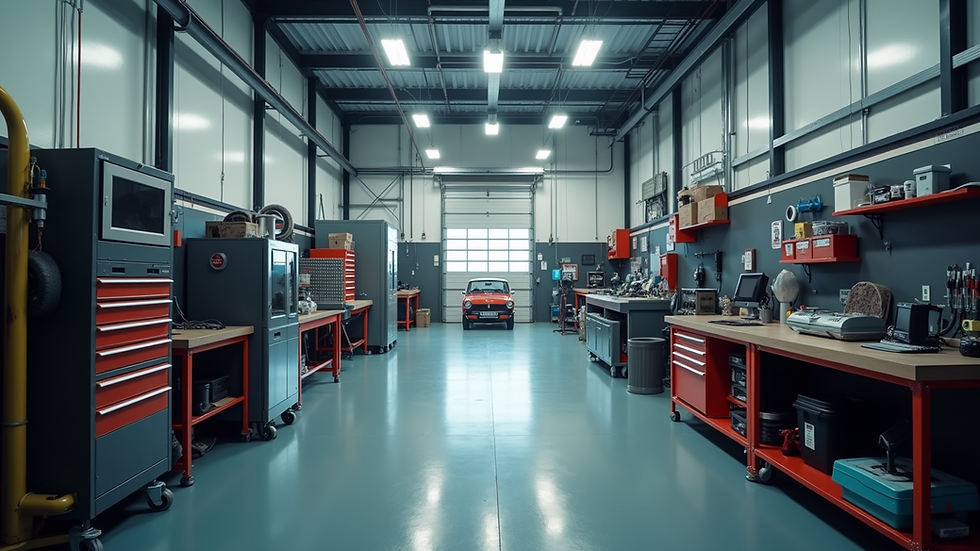Is your business at risk and you don't know it? Discover with us how to protect your assets
- Preventor Building Services Limited

- Jul 10
- 4 min read
Every business owner understands the critical need to protect their assets. Yet, many may overlook the fact that lacking a solid maintenance plan can expose them to unexpected risks that threaten their entire operation. A proactive approach to maintenance not only boosts efficiency but also ensures long-term success. In this blog post, we explore the hidden risks your business may face without a maintenance strategy and offer practical tips on how to mitigate those risks.
The Hidden Costs of Neglecting Maintenance
Maintenance is often seen as an unnecessary expense rather than a valuable investment. However, the costs of ignoring maintenance can quickly add up. For example, a single equipment failure can lead to costly emergency repairs. A survey by Managing Director of RS Industria shows that unplanned downtime can cost businesses an average of £100,000 per week in lost productivity, depending on the industry. This cost includes not only the direct expenses of repairing the equipment but also the loss of production and potential revenue. The survey also highlighted that companies are averaging 20 hours of unplanned downtime per week, with ageing assets being a major contributing factor.
Each time equipment malfunctions due to insufficient care, the consequences extend beyond immediate repair costs. There may be additional expenses associated with lost productivity, reduced employee morale, and even damage to your company's reputation.
Understanding Risk Exposure
Without a maintenance plan, businesses expose themselves to multiple risks. These risks could vary by industry, but common issues include:
Equipment breakdowns leading to halted production
Safety violations that can cause accidents or injuries
Increased operational costs due to urgent repairs and inefficiencies

Identifying Key Areas of Maintenance
To create an effective maintenance plan, it's crucial to pinpoint key areas within your business. Consider these focal points:
1. Equipment Maintenance
Regular servicing of machinery and technology is vital. This should include routine inspections, cleaning, and timely replacement of worn parts. Studies show that 80% of equipment failures can be prevented through proactive maintenance strategies.
Ignoring minor repairs can escalate into major problems. For instance, a £80 fix today could turn into a £400 emergency repair tomorrow. Establishing a comprehensive equipment maintenance schedule helps keep operations running smoothly.
2. Infrastructure Care
Your physical location requires continuous attention as well. This might involve routine checks of buildings, roofing, plumbing, and electrical systems.
Neglecting infrastructure can lead to significant issues. For example, roof leaks can result in thousands of dollars in damage and even force your business to close temporarily.
3. Technology Upgrades
In our digital age, up-to-date technology is essential. Outdated software can create vulnerabilities that risk data security and hinder performance.
Investing in regular technology assessments can prevent security breaches. In fact, a study from IBM found that companies with a proactive cybersecurity strategy can reduce data breach costs by up to 30%.
The Benefits of Having a Maintenance Plan
Developing a maintenance plan can seem overwhelming, but the positives far outweigh the costs. Here are some key benefits:
1. Increased Longevity of Assets
Routine maintenance can significantly extend the lifespan of your equipment and infrastructure. For example, businesses that follow established maintenance schedules see a 15% increase in asset lifespan. This not only reduces replacement needs but also optimizes performance.
2. Improved Safety and Compliance
Regular maintenance checks help ensure that safety standards are met, minimizing workplace accidents. Failing to comply with industry regulations can lead to fines and legal issues. According to GOV.UK, In 2022/23, the average fine per health and safety conviction was £145,000, and total fines in a single year exceeded £30 million.
3. Enhanced Productivity
Well-maintained equipment allows employees to work more effectively. According to a study by the McKinsey Global Institute, companies that prioritize maintenance improve productivity by an average of 20% due to reduced downtime.
Creating an Effective Maintenance Plan
Recognizing the importance of a maintenance plan is the first step. Here's how to develop a solid strategy:
Conduct an Assessment: Evaluate your current assets to identify critical components that need maintenance.
Create a Maintenance Schedule: Outline when each piece of equipment or area will be inspected and serviced.
Assign Responsibilities: Designate team members to manage different maintenance tasks to ensure accountability.
Track and Adjust: Use software or tools to monitor maintenance activities and adjust plans as needed based on performance data.
Take Action Now
In today’s competitive business landscape, the significance of a maintenance plan is undeniable. Understanding the hidden risks your business faces without one empowers you to take actionable steps to protect your assets.
Investing in a proactive maintenance strategy not only preserves your financial resources but also upholds your reputation and operational effectiveness. Don't wait for a crisis to highlight your vulnerabilities. Start prioritizing maintenance today to reduce risks and foster long-term growth.

Remember, the cost of neglecting maintenance can far exceed the expense of implementing a solid plan. Protect your business and pave the way for ongoing success by investing in maintenance today.


